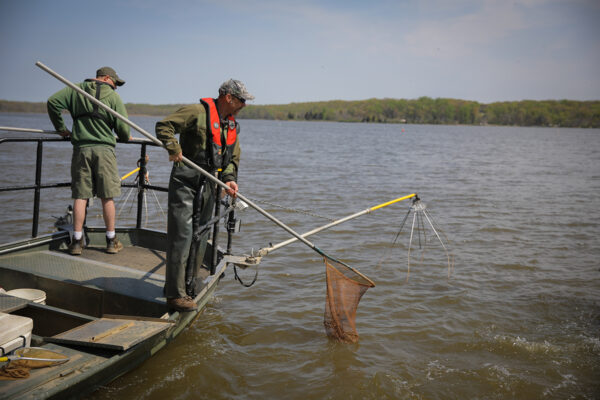
Artistic image of snakehead ©By David Hart
They were called “frankenfish” and “fishzilla,” as if they were created in the laboratory of a mad scientist. They even morphed into a mythological creature that could walk across dry land and survive out of water for days. The hysteria around snakeheads also spawned a rash of B-list movies. One included gruesome attacks by roving packs of six-foot fish that devoured swimmers, crashed boats, and slithered into lakeside cabins to gnaw on helpless teenagers.
But snakeheads are not the result of a freak experiment. They are nothing more than a fish native to Asia that somehow made its way into the tidal Potomac River more than a decade ago.
As it turns out, snakeheads can indeed wriggle across the ground for short distances. They can even live out of water for several days, thanks to their ability to breathe air, but they must be kept moist. They don’t attack swimmers, however, and they certainly won’t crawl into a house to eat children or pets.
Even better, snakeheads are not the ecological disaster many fisheries biologists feared, at least not in the Potomac. One early study suggested the river’s bass population would decline by one third if snakehead numbers were not controlled. There’s no question they prey on juvenile largemouth bass and other young game fish, but after more than a decade of research, snakeheads, it turns out, are just another fish.

Snakehead
“They seem to have reached an equilibrium with the other fish in the river and they occupy a niche that was largely unfilled,” says Regional Fisheries Biologist John Odenkirk, with the Department of Wildlife Resources (DWR). “The Potomac is a very fertile river. There seems to be plenty of food to go around, even with the addition of this new species.
“We’ve found 20 or 25 different items in their stomachs, which means they just eat what’s available at the time. Killifish, white perch, baby bluegills, crayfish, mice, whatever happens to be in front of them. They even eat their own young.”
The good news? They have not had any noticeable impact on the largemouth fishery. In other words, snakeheads are just another game fish in a system brimming with game fish. Well, not just another game fish. Watch a snakehead smash a topwater lure meant for bass and you might ditch your bass tackle and start fishing for snakeheads.
Because of those heart-stopping, lure-crushing strikes, the powerful runs, their voracious appetite and varied diet, snakeheads have turned into a bucket-list fish for a growing number of anglers throughout Virginia and the mid-Atlantic region. The good news is that snakeheads are not only abundant in parts of the Potomac, they are relatively easy to catch, says Potomac River guide Steve Chaconas. Make that, they are relatively easy to hook. Getting one to a net, however, isn’t necessarily turnkey.
“They have sharp teeth, so they can cut line pretty easily,” says Chaconas. “They are also incredibly strong and they are very good at burying themselves in grass and other cover. I use some pretty heavy tackle and 60-pound braided fishing line, which is more difficult to cut and it has less stretch than monofilament. You need to make long casts, which means it can be harder to get a good hook set if you use monofilament.”
Frogs Rule
That’s one reason he favors lures like hollow-body frogs. They are relatively heavy and can be cast much farther than lots of other lures. Frogs also float. Since snakeheads stay close to the surface much of the spring and summer, frogs are an ideal choice. Besides, who doesn’t love the sight of a big fish exploding on a topwater lure?
A variety of other surface baits work, but hollow-body frogs have a number of distinct advantages. First, says Chaconas, they are weedless. Since snakeheads prefer thick aquatic vegetation and heavy wood cover, it’s all but impossible to use a lure with exposed hooks.
Frogs also make lots of noise. Snakeheads not only hunt by sight, they also hunt by sound. And frogs have heavier hooks than most baits. The fish are strong enough to bend thinner hooks found on other lures.
Those heavier hooks, combined with beefy tackle and thicker line, can help you get more fish in the boat, but you have to hook them first. That can be difficult. As a guide, Chaconas sees many of his clients set the hook at the wrong time.
“Watch the lure. Set the hook when it disappears, not when a fish hits it. A lot of times, they sort of slash at it without actually taking it in their mouths, so it’s important to wait until they eat it,” he says. “When they do take it, you need to set the hook hard, which is why braided line is the best choice. They have bony mouths.”
He favors black frogs, but he says color doesn’t always seem to matter. When he’s guiding inexperienced anglers, Chaconas will tie on a white or green frog because they are easier to see.
“It’s hard to resist setting the hook on that initial strike,” he says. “Wait until you can’t see the lure.”

Electrofishing for snakeheads
The harder part is simply putting one of those lures in front of them. Although the fish are widely scattered throughout the tidal Potomac, their numbers are actually down from a few years ago, reports Odenkirk. Sampling data from Little Hunting Creek, for example, found an estimated 617 fish in the tributary in 2013, but only 350 in 2015. He’s finding fewer fish in other places that had lots of them five years ago.
There’s a likely explanation, he and Chaconas agree. As more anglers discover the thrill of casting to and battling these fish, they are putting more pressure on the new fishery. Although some anglers release them, many do exactly what fisheries managers urge them to do: keep them. Snakeheads are not just a fun fish to catch, they are fine table fare. Commercial fishermen also target them in Maryland waters, thanks to a growing demand for the meat.
“There has been a large interest in bow fishing for them, too,” says Odenkirk. “Because they need to gulp air to survive, they are often close to the surface, making them a prime target for bow fishermen. A lot of guys are targeting them at night with boats rigged with lights.”
As such, the average size of the fish he and his fellow biologists catch during electrofishing efforts has decreased from about five pounds to three or four. Plenty of big ones remain, though. A Maryland bow fisherman landed an 18.42-pounder in 2016 and Odenkirk catches fish over 10 pounds regularly while electrofishing.
Snakes In The Grass
Even with fewer fish in the river, there are still plenty enough to justify fishing for them. Odenkirk says that although snakehead populations are down in the upper sections of the tidal Potomac, their numbers remain strong in creeks farther south all the way down to the Colonial Beach area. They are not randomly scattered throughout the river, though. Snakeheads have very specific habitat needs, making them relatively easy to target.
“In the spring, they stay around wood cover like docks and fallen trees, but as the aquatic vegetation grows, they move to those areas. They really like hydrilla,” says Chaconas.
Not just any hydrilla, though. He and Odenkirk find the highest concentrations in warm, shallow water as far away from current as possible. That means they are often close to shore on the back side of large areas of submerged and standing aquatic plants in the upper segments of the river’s major tributaries. Which also means they can be tough to reach for anglers in large boats.
“The guys who use kayaks can get to places a bass boat can’t,” says Chaconas. “They can go way back into the grass and pads in real shallow water. A kayak is really the best way to fish for them, but plenty of guys do catch them from bass boats.”

One of countless snakeheads that Potomac River guide Captain Steve Chaconas and his clients have caught. Their numbers may be down, but some sections of the Potomac hold lots of these hard-fighting fish. Photo by David Hart.
Snakeheads are also showing up in a number of places that don’t offer the security of wide mudflats and vast stands of aquatic plants. Despite warnings and even laws preventing the transport of live snakeheads and their release into public waters, a number of anglers have done just that. One Virginia angler was actually fined after admitting he released snakeheads into Lake Brittle, which now has an established population. So do a number of other waters, including Lake Abel, Burke Lake, and Pelham, Occoquan, and Hunting Run reservoirs. Whether or not they will settle into their own niche without harming the existing fisheries remains to be seen. In the meantime, Odenkirk encourages anglers to target snakeheads in those waters. He only asks that when you catch one, kill it and then take it home and eat it.
More important, don’t transport live fish and, above all, do not stock them anywhere, even in a pond that may seem isolated. They may not be able to walk for miles across dry land and they don’t chase screaming teenagers, but why take chances?
Learn More:
- Snakehead Identification: Do You Know The Difference?
- Mapping Where Snakehead Fish Are Found in Virginia
Read More Great Stories from Virginia Wildlife by Subscribing Today
This article originally appeared in the May/June 2017 issue of Virginia Wildlife magazine.
The author of this article, David Hart, is a full-time freelance writer and photographer from Rice. He is a regular contributor to numerous national hunting and fishing magazines. Contact him at hartfish1@gmail.com.

This article originally appeared in Virginia Wildlife Magazine.
For more information-packed articles and award-winning images, subscribe today!
Learn More & Subscribe







